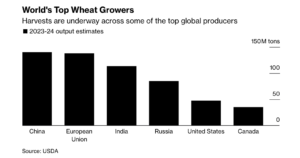Bloomberg's Clarice Couto reported this past Friday that "a surprising tax change in agriculture powerhouse Brazil has the potential to make soy grown in the world’s largest bean exporter less…
Ukraine Challenges Russian Black Sea Blockade with “Humanitarian Corridor,” While China Floods Hit Corn Crops
Jared Malsin and Anastasiia Malenko reported in today’s Wall Street Journal that, “Ukraine said it was opening temporary routes for civilian ships to sail from its Black Sea ports in a potential challenge to Russia’s attempt to blockade the country’s globally important food exports.
“The new routes would primarily be used to open an exit route for ships that have been trapped in Ukraine’s ports since Russia’s full-scale invasion in February 2022, the Ukrainian navy said in a statement.
“The navy also said that ‘throughout all routes there is a military threat and mine danger from the Russian Federation.’ Any vessels whose owners or captains said they are ready to sail in these conditions could pass to or from three ports around the city of Odesa, it added.”

The Journal writers pointed out that, “It remains unclear if any commercial shipowners, insurers and ship captains will participate in the plan.”
“All commercial shipping to Ukraine’s major Black Sea ports ceased last month after Russia withdrew from an international agreement that guaranteed the safety of ships carrying grain and other food products from Ukraine,” the Journal article said.
Today’s article explained that, “Since the deal unraveled in July, Ukraine has continued to export grain overland and on smaller boats via the Danube River. Turkish and U.N. officials are under pressure to negotiate a resumption of the deal by September when Ukraine’s grain harvest will begin to pile up, creating a backlog that could be difficult to export.”
Reuters writer Olena Harmash reported yesterday that, “Ukraine announced a ‘humanitarian corridor‘ in the Black Sea on Thursday to release cargo ships trapped in its ports since the outbreak of war, a new test of Russia’s de facto blockade since Moscow abandoned a deal last month to let Kyiv export grain.
“At least initially, the corridor would apply to vessels such as container ships that have been stuck in Ukrainian ports since the February 2022 invasion, and were not covered by the deal that opened the ports for grain shipments last year.
“But it could be a major test of Ukraine’s ability to reopen sea lanes at a time when Russia is trying to reimpose its de-facto blockade, having abandoned the grain deal last month. Shipping and insurance sources expressed concerns about safety.”
The Reuters article added that, “‘I think it will not be an exaggeration to say that President Erdogan is probably the only man in the world who can convince President Putin to return to the Black Sea Grain Initiative,’ Ukrainian Foreign Minister Dmitro Kuleba told Reuters in an interview on Thursday.
“A German grain trader told Reuters: ‘People want more details about the Ukrainian temporary shipping channel announced today as it cannot work unless Russia gives a concrete commitment not to attack the ships.'”
Dow Jones writer Kirk Maltais reported yesterday that, “Traders are watching to see how the introduction of ‘temporary’ shipping corridors in the Black Sea will play out – the chief question being if Russia will allow them to transit peacefully.”
Elsewhere, Reuters writer Naveen Thukral reported today that, “The U.S. Department of Agriculture (USDA) said early Thursday that export sales of soybeans totalled 1.503 million metric tons in the week ended Aug. 3. Analysts had predicted a weekly total between 300,000 metric tons and 1.8 million metric tons.
“China, the top buyer of the oilseed, accounted for 767,800 metric tons, reflecting a recent string of deals.
“Corn export sales of 908,800 metric tons were in line with expectations of 275,000 metric tons to 1.2 million metric tons. Wheat export sales of 561,200 metric tons topped the high-end of forecasts that ranged from 200,000 to 500,000 metric tons.”
Meanwhile, Bloomberg writers Megan Durisin, Aine Quinn, Hallie Gu, and Michael Hirtzer reported yesterday that,
Wheat harvests rolling in across the Northern Hemisphere are bolstering global supply. But bad weather and the war in Ukraine are leaving top-quality crops harder to come by.
“Tractors in northern Europe have been stalled by persistent rain, while Ukrainian wheat quality has also been dented as Russia’s invasion drains farmers’ funds. As for China, much of the harvest is only suitable for feeding to chickens and pigs.

“That’s curbing the portion of wheat suitable for food staples like bread and noodles, even as global production could still notch an all-time high. It will also heighten focus on exporters further south, where harvests lie several months ahead.”
More narrowly regarding China, Reuters writers Naveen Thukral and Qin Ningwei reported today that, “Floods have damaged corn and rice crops in China’s key northern grain-producing belt, traders and analysts said, with more rain in the forecast as another typhoon approaches, threatening to add to global food inflation pressures.
“The hit to China’s cereal crops – the full extent of which is not yet clear – comes as consumers worldwide face tightening food supplies amid India’s ban on rice exports last month and disruptions in Black Sea grain shipments caused by the war in Ukraine.”
And Scott Dance and Christian Shepherd reported in today’s Washington Post that, “Now, [China] is reckoning with more unprecedented precipitation — at one spot last week, 2½ feet of rain fell within about 3½ days. The flooding that it caused in Beijing and neighboring Hebei province killed at least 33 people and caused damage that could take years to repair: destruction to tens of thousands of homes and dozens of roads and bridges, and inundation of swaths of cropland. The disaster hit on the heels of record heat and, on the other side of the country, drought.”
“As the planet baked during a record-hot July, China saw some of the planet’s most intense heat and precipitation,” the Post article said; adding that: “Then came an onslaught of tropical rains from Typhoon Doksuri. Rainfall at a Beijing reservoir totaled more than 29 inches from July 29 through Aug. 2, the highest reading in the capital city in 140 years of record-keeping, according to Beijing officials. The resulting floods in Beijing and Hebei forced 1.3 million people to evacuate.”
“On the other side of the country, meanwhile, years of drought continue along the Mekong River basin, worsened by Chinese dams and their demand for electricity. The situation is threatening food insecurity from southwestern China into Cambodia, Laos, Thailand and Vietnam,” the Post article said.







